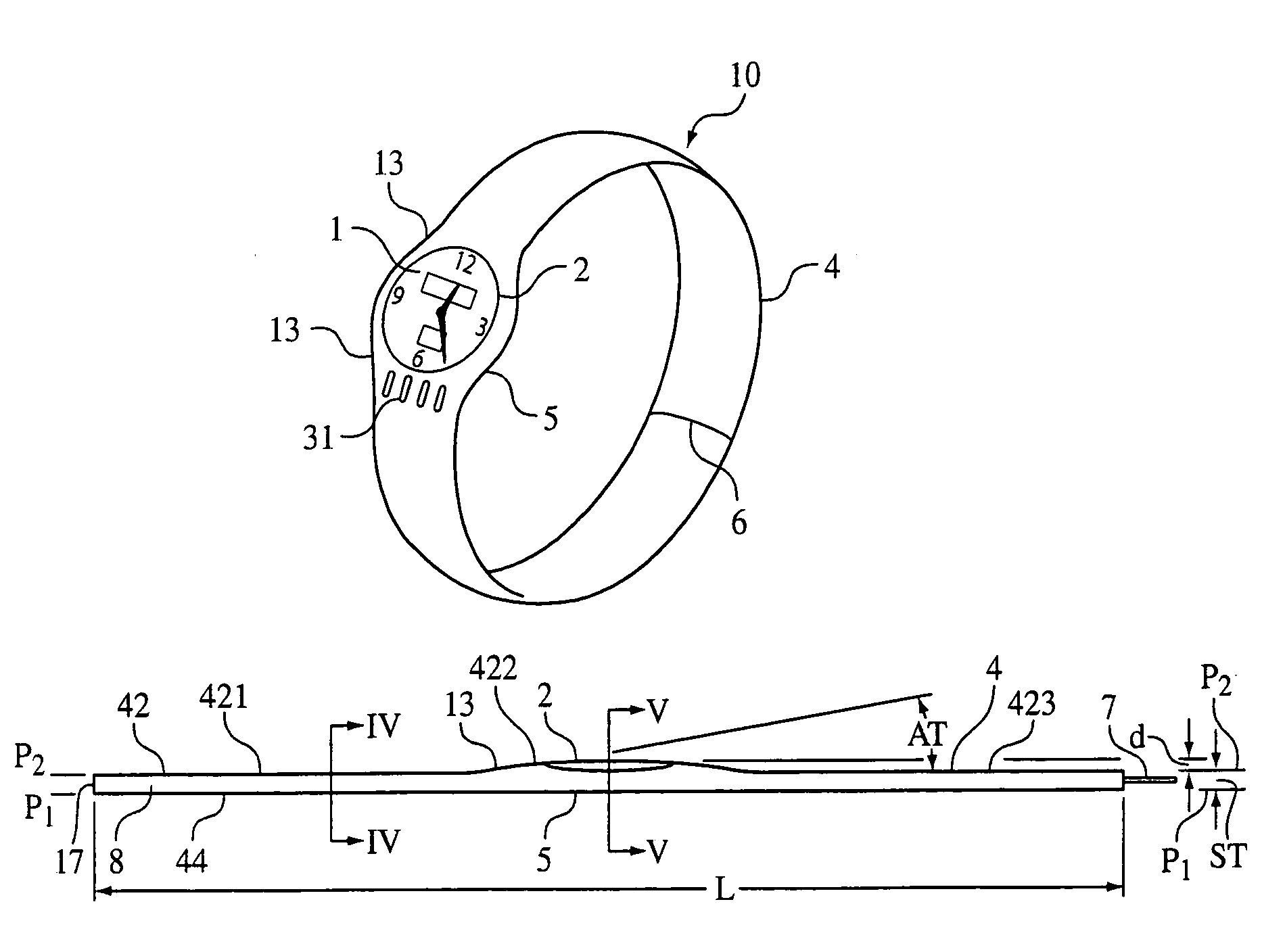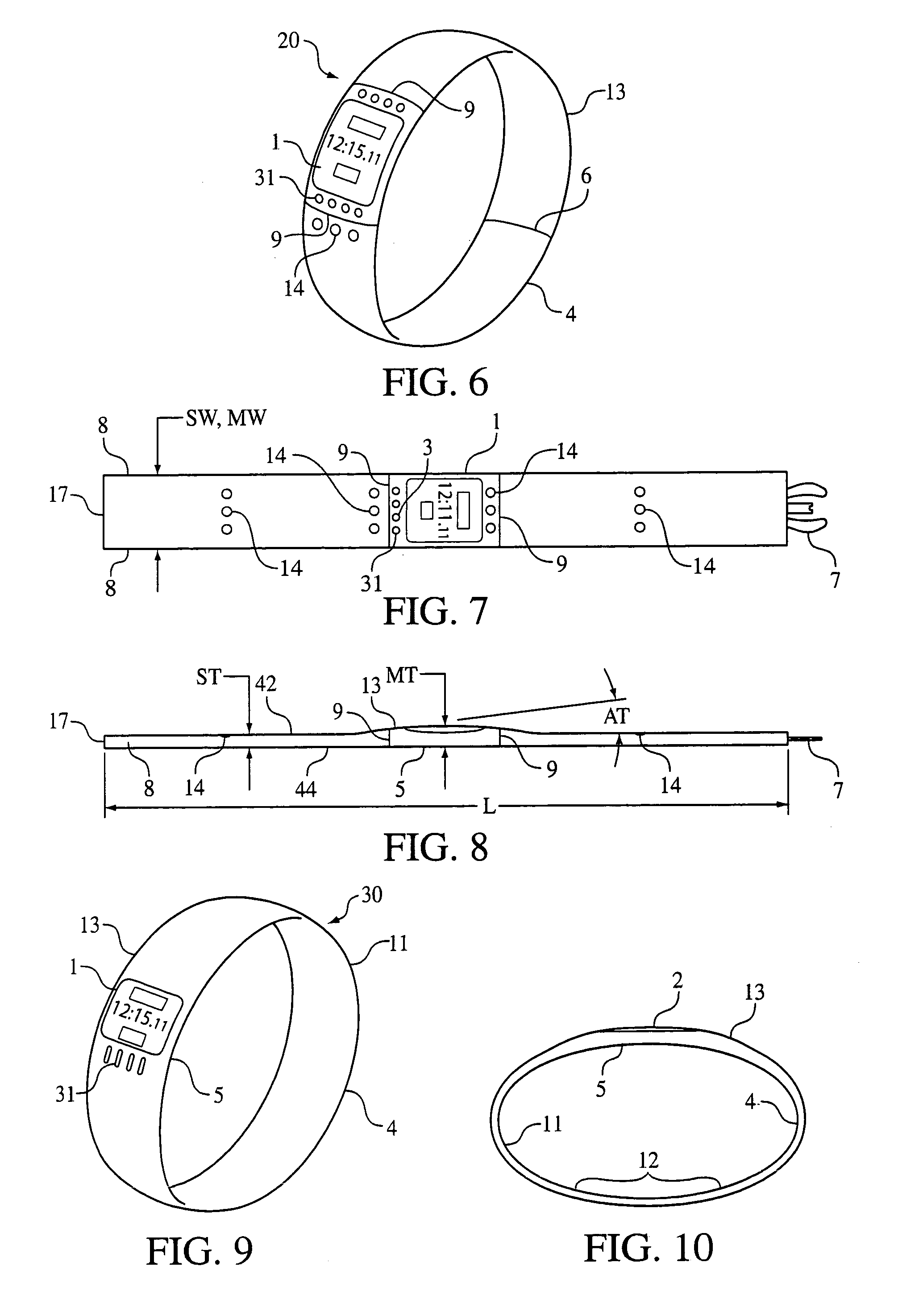Commonly worn wristwatches often incorporate elements that may
bruise, snag or tear the exposed skin of persons whom the wearer of the watch may contact.
Clothing may be pulled, which can also cause
skin damage.
The potentially harmful elements of wristwatches may include the watch case itself, the bezel, the
crystal, the hinges, the stems, the stem knobs, the horns or lugs for bracelet or strap attachments, the bracelets or straps themselves, other attachments including ornamentation and insignia, clasps, including buckles and arrangements using hook and loop fasteners of the type generally known as VELCRO which can scratch and scrape the skin, and the shape and bulk of the watch itself, including watches with excessively high profiles, widths or hard, sharp edges.
Although brushing against or being struck by a worn wristwatch may cause skin
tears and damage at any time,
skin damage is relatively more likely to occur in situations such as the feeding, care and handling of infants and children, assisting and caring for the ill, aged and other persons with brittle skin and dermatological problems, and in events involving the possibilities of hard contact, e.g., certain athletic activities.
This problem is important: skin scrapes,
tears, punctures and contusions can be highly dangerous where healing processes may be slow or problematic and / or the potentials or likelihoods exist for infection.
Rules, however, regarding the wearing of wristwatches while performing certain tasks are difficult to enforce and limited in application.
Moreover, despite this long standing problem, there has been no satisfactory solution.
None have been found which do not retain or incorporate features that may scratch or tear skin.
None were found which aimed at or mitigated the potential for the wristwatch to cause harm to persons other than the wearer that the wristwatch might contact, and many, because of their increased bulk and other factors appear to actually increase the possibilities that they will
cause injury to persons, other than the wearer, that the watch might contact.
Applicants' reviews of numerous catalogs of wristwatch offerings and inspections of wristwatch displays in major stores have also failed to reveal any models which address the problems of injuries to persons other than the wearer, whom the watch may come in contact with when worn.
Rappaport's design, however, does not have flowing contours and surfaces substantially smooth to the touch.
The outside edges of the parametric welds which form this wristwatch may also present particularly hard edges to persons with whom they may come in contact.
However, such catches can scratch and scrape the skin.
When this type of closure is worn by a person with a large
wrist, a length of the hook or loop
fastener remains entirely exposed when the clasp is closed, and when worn by a person with a small
wrist the closure results in a longer double thickness of strap, plus hook and loop, which may also catch and snag.
Although Freeman et al. states that his device “may be narrower than a
smart card” it is clear that the device is large and bulky and not snag-free.
's device, however, requires a very large display to support and permit usage of the various functions of the device.
All these functions require a large display area and requirements for easy to use control, which taken together, are major factors in establishing the dimensions of a large and bulky device.
's device is shown having a width that is relatively large compared to its length, and it is clear from the drawings that the device is large and bulky and hardly snag-free.
Freeman et al. further uses a
polymer edging 20 to “add comfort to a wearer” which indicates that the device is so large and bulky that users would find it uncomfortable to wear if the edging were not provided.
The
polymer edging also presents another surface that could harm a person other than the wearer.
From a
snagging perspective, with its protruding buckle rails and protruding strap, this design is potentially dangerous.
Because of its bulk, lack of smoothness and protrusions, Freeman et al.
's device could not be used in situations such as caring for the ill and aged where contact is frequent and the
resultant injuries and contusions can be highly dangerous.
Moreover, even if Freeman et al.
's device were to incorporate a snag free clasp such as a bayonet clasp, the device would still have a non-
smooth surface and be overly large and bulky to accommodate the various input keys and electronic devices incorporated in the device.
's device in multiple sizes would add production, inventory and retailing complications and also added cost penalties.
Uses of buckle and hook and loop
fastener catches are, moreover, widely accepted on heart monitors and
wrist-worn devices intended to be sold to joggers and for athletic pursuits, while use of a bayonet catch on such devices, with the added complication of
sizing issues, might encounter
consumer resistance.
Because of these disadvantages and cost penalties, it is highly unlikely that one skilled in the art would use a bayonet clasp on Freeman et al.
Rigid bracelets are not snag-free and
pose a risk to those other than the wearer with whom the watch comes in contact.
When passing in sliding motions parallel to the axis of the wrist of the wearer, a rigid bracelet would, upon contact with another person, cant and cock and its hard edges would tend to injure.
The opening in the “
cuff” type rigid bracelet would also tend to catch and injure.
The extreme width of the strap to accommodate the closures would increase the likelihood of contact with persons other than the wearer.
The great bulkiness of Bruce increases the likelihood that the wristwatch may come in contact with and harm persons other than the wearer.
The central portion of Bruce's band must also be constructed of semi-rigid material in order to maintain the “S” configuration and the arch structure, and this required stiffness of the band in Bruce would further increase the probability of harm to others.
Thus, Bruce's design is far from snag-free and is not free of protruding elements.
U.S. Pat. No. 6,388,612 to Neher discloses a bayonet-type clasp means, but the Neher device itself is far from snag-free and smooth in its entirety.
Thus, not only is the Neher device not a wristwatch, the device is far from snag-free and cannot be used as a safety wristwatch
system.
The bayonet clasp probably best met these requirements, but even with this clasp the Neher device will not avoid causing injuries to persons other than the wearer.
Thus, although the Schickedanz timepiece may be flexible, the Schickedanz timepiece is far from snag-free and cannot function as a safety wristwatch.
The drawings in Schickedanz, moreover, show many sharp edges on the rigid display material, and the timepiece appears to be rigid in the direction of the axis of the wrist of the wearer such that the bangle may cock and cause damage upon contact with a person other than the wearer.
Staph infections can occur when the integrity of the
skin barrier is broken through
surgical procedures, scrapes and scratches, or in other ways, and they can cause serious and sometimes fatal illness in the most vulnerable, including newborns, certain diabetics, and the elderly.
Staph
bacteria are the number one cause of hospital infections, are becoming increasingly resistant to treatment, and are a serious
public health problem.
 Login to View More
Login to View More  Login to View More
Login to View More 


